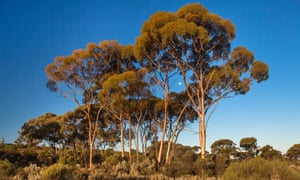Scientists’ call follows national assessment that finds gum trees in Western Australia wheat belt suffering worst rate of decline

Eucalyptus trees in Western Australia. Scientists have recommended after a study that 147 eucalypt species be added to the nation’s national threatened species list. Photograph: blickwinkel/Alamy Stock Photo

Eucalyptus trees in Western Australia. Scientists have recommended after a study that 147 eucalypt species be added to the nation’s national threatened species list. Photograph: blickwinkel/Alamy Stock Photo
An iconic Western Australian eucalypt, known for the size of flowers, is among almost 150 eucalpyt species scientists have recommended be listed as threatened under national environment laws.
The eucalyptus macrocarpa, commonly known as mottlecah, has the largest flowers of all eucalypt species. The bright red flowers can measure up to 10cm in diameter.
It is one of 147 eucalypt species that a team of scientists has recommended be added to Australia’s national threatened species list.
Eucalypts in the wheat belt of Western Australia were identified as having the worst rate of decline, with about 60 species in this region identified by the researchers as qualifying for a listing as either vulnerable, endangered or critically endangered.
The eucalyptus macrocarpa, commonly known as mottlecah, has the largest flowers of all eucalypt species. The bright red flowers can measure up to 10cm in diameter.
It is one of 147 eucalypt species that a team of scientists has recommended be added to Australia’s national threatened species list.
Eucalypts in the wheat belt of Western Australia were identified as having the worst rate of decline, with about 60 species in this region identified by the researchers as qualifying for a listing as either vulnerable, endangered or critically endangered.
Rod Fensham, an associate professor at the University of Queensland, led the research that used maps of eucalyptus distribution and maps of land use to measure which species were in decline.
“Eucalypts are just fundamentally Australian. They define the continent, really,” Fensham said. “Everywhere you are in Australia there will be a gum tree, and the gum tree will tell you something about where you are.”
The scientists assessed all 822 eucalypt species found in Australia and determined 193 (23%) were threatened. Before the research, 89 eucalypts were listed as threatened under national laws. The paper suggests that 32 of these species could be removed from that list.
Eucalypts are long-lived species and the scientists measured their trajectory over 10 generations.
“Ten generations is quite a long time,” Fensham said. “But there are many species, including ones that were recommended for listing, that are showing such a steep rate of decline through the course of European history that that’s their trajectory, that they’ll be extinct in 10 generations.”
Fensham said this included relatively common species that drivers would be used to seeing along highways on the east coast between Sydney and Melbourne.
The greatest threat to eucalpyts by far was conversion of land by the agriculture industry for cropping or pasture. That was followed by urban development.
Species such as the mottlecah in WA’s wheat belt were under particular threat because intensive land use was occurring over a large area where there was also a high number of eucalypt species.
“The No 1 conservation measure is stop land clearing, stop clearing habitat,” Fensham said. “It always is and we still haven’t managed to do it in Australia.”
Late last year, the International Union for Conservation of Nature’s updated Red List reached similar results, finding almost a quarter of the world’s eucalypts were threatened with extinction.
No comments:
Post a Comment